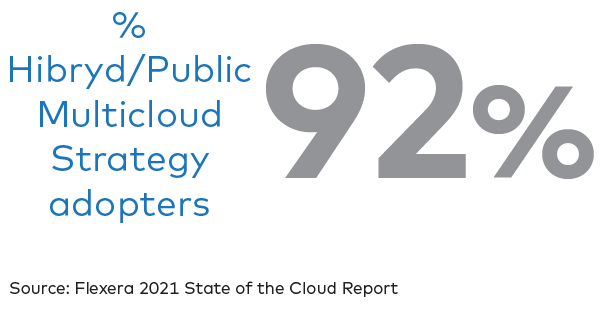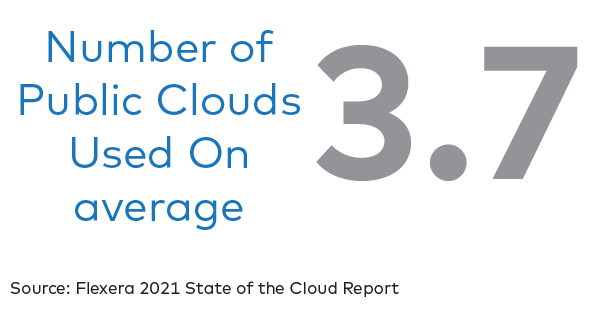MultiCloud has become a frequently used word among IT managers. A new world is opening up in the market where all the needed aspects to use multiple clouds simultaneously must be considered, and how to connect to them has become a priority.
Companies are adopting multicloud strategies. Over the past year and with the help of Covid 19, cloud deployments have accelerated around the Globe. It is known that the cloud, by offering truly dynamic and virtually unlimited IT infrastructure capabilities, accelerates digitalization and serves as a basis for any digital transformation strategy. The cloud embraces innovation, which is key to a successful transformation. At the same time, well-founded digital transformation strategies improve the efficiency and the benefits that any cloud strategy can give.
In this context, the evolution of workloads to the cloud has positioned itself as a fundamental enabler. It allows, among other things, to shorten the time required for any technological deployment. The increasing rise in the use of multiple types of clouds (private, public, hybrid) across different types of service providers (IaaS, PaaS, and SaaS) is driving companies’ need to manage their multicloud services, combining technology and business needs with cost optimization or compliance requirements.
According to IDC, 40% of core IT spending is expected to be cloud-related by 2022 and this percentage increases to 80% by 2028.
Furthermore, multicloud management provides the following benefits to organizations:
![]() Identify which workloads are eligible for the public cloud and which are for a private cloud and benefit from the advantages of each service.
Identify which workloads are eligible for the public cloud and which are for a private cloud and benefit from the advantages of each service.
![]() Count on cloud service experts who can implement and operate a multicloud strategy.
Count on cloud service experts who can implement and operate a multicloud strategy.
![]() Avoid dependence on only one provider (vendor Lock-in), that prevents the customer from getting all the possibilities that the market can offer.
Avoid dependence on only one provider (vendor Lock-in), that prevents the customer from getting all the possibilities that the market can offer.
![]() Maximize security and availability, because they will not depend on a single service or provider. In this way, companies can benefit from the high-security standards of the different services.
Maximize security and availability, because they will not depend on a single service or provider. In this way, companies can benefit from the high-security standards of the different services.
![]() Diversify workloads, avoiding a single team from taking on a lot of work.
Diversify workloads, avoiding a single team from taking on a lot of work.
![]() Make continuous evaluation of cloud service providers in the market, as well as security and legal requirements.
Make continuous evaluation of cloud service providers in the market, as well as security and legal requirements.
![]() Pay only for the service they want and use.
Pay only for the service they want and use.
The benefits mentioned before are excellent so far, the cloud is flexible and promises you can access your critical data and systems from anywhere, however when we talk about communication between different clouds it is not as direct as expected and creates complications. The solution that many companies find is to send the information from one cloud to their on-premises datacenter to upload it back to the other cloud provider, this solution is not efficient at all, neither from the connectivity to the different clouds nor from the need to continue having its own data center that acts as a pivot between the different clouds. The option of including the connection between the different clouds as a part of the corporate network is not a viable solution either, because of its costs and the complexity of connecting it to each cloud.

Given the growth of the Multicloud trend within the corporate world, Transtelco’s Backbone network has taken on great preponderance. It was conceived as cloud-enabled technology and connects the most relevant public clouds in the market and also their different regions with each other, offering a wide range of connection possibilities for companies and enhancing the advantages described above.
Transtelco offers multiple possibilities when hiring bandwidths for each cloud and for customer sites, according to the company needs and its projections for growth. These changes can be done with a simple service change request via the customer portal.
As can be seen in the above graphic, the connection to the clouds can be made directly from each office connected to the Transtelco network, and can even be done directly by the remote user who is connected from home through our Remote Access On Ramp service that connects the user’s home with our local POP through a secure tunnel in their home internet connection.
One of the big uncertainties companies face is related to the importance of the uploaded information to the cloud, how to preserve that information safe from strangers, and how to keep it always available. This is where Transtelco’s flexibility offers, not only the possibility of contracting different levels of service for its connections to the cloud, but also the possibility of data encryption from the client’s virtual servers in the cloud to their offices, being the same client the only one who has access and manage the encryption. Moreover, in order to connect to different clouds, you can hire cloud port packages that you can use according to your needs, for different regions of the same cloud, for different clouds or a combination of both.


In the same way, when you need to carry your data from one cloud to another, a Cloud Connect optional service, Intercloud, can connect your resources in different clouds or regions, directly, cloud to cloud at layer 3, achieving a very high transfer speed and efficiency by moving traffic directly from one cloud to another without going through the local data center. All of this can be quickly configured through our software-defined backbone, which is already connected to the main data centers of the most relevant public clouds, directly and without intermediaries. This allows total transparency in the service and assures end-to-end support since everything happens within the Transtelco network.
Cloud services are only as good as the network
that connects them.
Cloud services are increasingly flexible and offer multiple possibilities. Connectivity must be up to the task so that these benefits can be harnessed. We work every day on this, to connect companies in an agile, simple and fast way.





